In “What Happened to You?: Conversations on Trauma, Resilience, and Healing,” renowned psychiatrist and neuroscientist Bruce D. Perry collaborates with award-winning journalist Oprah Winfrey to explore the impact of trauma and offer insights into the journey of healing and resilience. Delving into the core question of “What happened to you?” rather than the traditional “What’s wrong with you?” the book presents a groundbreaking approach to understanding, empathizing, and healing from the diverse range of traumas individuals experience. Through engaging conversations and scientific research, Perry and Winfrey aim to transform the way we perceive and respond to trauma, ultimately fostering a more compassionate and healing society.
Chapter 1: Introduction to Trauma
Chapter 1 of “What Happened to You?” by Bruce D. Perry provides an in-depth introduction to trauma, setting the stage for a comprehensive understanding of its effects on individuals. The chapter explores the definition of trauma and its prevalence in society, emphasizing that no one is immune to its impacts.
Perry explains that trauma refers to any distressing event or experience that overwhelms an individual’s ability to cope. It can result from various circumstances, including physical, emotional, or sexual abuse, neglect, natural disasters, accidents, or even witnessing violence. The author asserts that trauma is not limited to extreme events and can also arise from chronic stressors such as poverty, discrimination, or ongoing difficult relationships. Importantly, Perry highlights how trauma affects the brain, shaping an individual’s perceptions, emotions, and behavior.
The chapter further highlights the universality of trauma, emphasizing that it is not isolated to specific demographics or socio-economic backgrounds. It illustrates how trauma impacts people across all ages, genders, races, and cultures. Perry also sheds light on the varying manifestations of trauma, as individuals may respond differently to similar experiences depending on their personal history, resilience, and support systems.
Perry concludes by emphasizing that understanding trauma is crucial for society to effectively address and heal from its impact. By adopting a trauma-informed approach, individuals and communities can create environments that promote healing, resilience, and growth. This introductory chapter successfully lays the foundation for the book, piquing readers’ interest to delve deeper into the complex and transformative subject of trauma.
Chapter 2: Understanding the Developing Brain
Chapter 2 of “What Happened to You?” by Bruce D. Perry delves into the understanding of the developing brain. It explores how early experiences shape brain development and the impact of trauma on the developing brain.
The chapter begins by emphasizing the remarkable plasticity and malleability of the brain during early childhood. Perry explains that the brain undergoes rapid growth and development, with connections between neurons being formed at an astonishing rate. He highlights the critical role of positive interactions and nurturing relationships in creating a healthy brain architecture.
Perry then introduces the concept of “developmental trauma,” which refers to the impact of adverse experiences on a young child’s brain development. Trauma disrupts the normal processes of brain development, impairing the child’s ability to regulate emotions, form healthy attachments, and learn effectively. The author emphasizes that trauma has a cumulative effect and that repeated exposure to adverse experiences can compound its impact on the developing brain.
Moreover, the chapter discusses the role of stress in brain development. Perry emphasizes that moderate levels of stress can be beneficial, as they help children develop resilience and coping skills. However, excessive or chronic stress can have damaging effects, leading to chronic states of fear and anxiety.
Perry concludes the chapter by emphasizing the importance of understanding brain development in providing effective interventions for children who have experienced trauma. He highlights the need to focus on creating environments that promote safety and security, as well as providing nurturing relationships and opportunities for healing.
Overall, Chapter 2 of “What Happened to You?” provides a comprehensive overview of the developing brain and the impact of trauma. It emphasizes the critical role of early experiences in shaping brain architecture and highlights the importance of understanding these processes to effectively support children who have experienced trauma.
Chapter 3: Adverse Childhood Experiences (ACEs)
Chapter 3 of “What Happened to You?” by Bruce D. Perry explores the concept of Adverse Childhood Experiences (ACEs) and their profound impact on a person’s well-being throughout their lifetime. Perry begins by defining ACEs as stressful or traumatic events that occur before the age of 18. These experiences can range from physical, emotional, or sexual abuse to neglect or household dysfunction.
The chapter emphasizes the groundbreaking research conducted by Kaiser Permanente and the Centers for Disease Control and Prevention (CDC), which first identified the prevalence and detrimental consequences of ACEs. The studies found that ACEs are shockingly common, with a significant portion of the population reporting at least one adverse experience during childhood.
Perry explains how ACEs exert a significant influence on a person’s physical and mental health, leading to an increased risk of various illnesses, substance abuse, and even premature death. These experiences shape the developing brain, altering neural pathways and impacting an individual’s ability to regulate emotions, form healthy relationships, and handle stress effectively.
However, the author highlights that understanding ACEs is not about assigning blame to parents or caregivers but rather recognizing the complex interplay of genetics, individual differences, and environmental factors that contribute to these experiences. Perry also offers hope by emphasizing that early intervention, supportive relationships, and resilience-building strategies can mitigate the impact of ACEs on an individual’s life.
In conclusion, Chapter 3 of “What Happened to You?” provides a comprehensive overview of ACEs and their far-reaching consequences on an individual’s health and well-being. By shedding light on this topic, Perry aims to foster empathy, compassion, and a collective responsibility to create nurturing environments that promote healing and resilience for individuals impacted by ACEs.
Chapter 4: Trauma-Informed Approach

Chapter 4 of “What Happened to You?” by Bruce D. Perry explores the concept of a trauma-informed approach. The chapter delves into how understanding trauma can revolutionize the way we interact with individuals who have experienced adversities in their lives.
Perry emphasizes that trauma can result from a variety of sources, including abuse, neglect, violence, or challenging life circumstances. These experiences can have a profound impact on a person’s development and physiological responses, particularly during childhood. Therefore, it is crucial to adopt a trauma-informed approach when engaging with individuals who have suffered traumas.
The author describes six guiding principles of a trauma-informed approach. Firstly, it is essential to prioritize safety, creating an environment where individuals feel secure and protected. Second, collaboration and trust-building are vital, ensuring that individuals have a say in their treatment and understanding that healthy relationships are critical to healing.
The third principle is promoting choice and empowerment, recognizing that individuals need to regain a sense of control over their lives. Next, it is crucial to address the individuals’ cultural, historical, and gender backgrounds, as these factors significantly impact trauma experiences. A whole-person perspective is emphasized, considering the interconnectedness of physical, psychological, and social well-being.
Lastly, Perry highlights the significance of resilience-building. Rather than focusing solely on deficits, it is crucial to recognize and nurture individuals’ existing strengths to facilitate their healing journey.
Throughout the chapter, Perry provides compelling examples and anecdotes to reinforce the importance of a trauma-informed approach. He stresses that such an approach can fundamentally transform how we support and interact with individuals impacted by trauma, enabling healing, and promoting growth and resilience.
Chapter 5: Resilience and Healing
Chapter 5 of the book “What Happened to You?” by Bruce D. Perry, titled “Resilience and Healing,” delves into the concepts of resilience and healing in the context of trauma. Perry emphasizes the importance of understanding that resilience is not an innate quality of an individual but rather a reaction to experiences and environments.
The chapter outlines the three key components that contribute to resilience and healing: relationships, self-regulation, and stress response. Perry stresses that building healthy relationships is crucial in overcoming trauma and becoming resilient. These relationships can provide the necessary support, nurture, and empathy that help individuals heal. Additionally, healthy relationships can help individuals develop self-regulation, which involves managing emotions, thoughts, and behaviors. This self-regulation is a vital skill in bouncing back from trauma.
Perry also explores the impact of stress on resilience and healing. Stress response is a normal and necessary mechanism that enables humans to adapt and survive threats. However, chronic or extreme stress can be detrimental to resilience and healing. Understanding the factors that influence stress response and how to modulate it is crucial in healing from trauma.
The chapter emphasizes the importance of trauma-informed care, which focuses on understanding the impact of trauma on individuals and providing appropriate support rather than asking “What’s wrong with you?” Perry encourages readers to shift their mindset to “What happened to you?” as a more empathetic and healing approach.
Ultimately, Chapter 5 highlights the significant roles of relationships, self-regulation, and stress response in building resilience and healing from trauma. It provides valuable insights and practical strategies for individuals, caregivers, and professionals to create environments that foster healing and promote resilience.
Chapter 6: The Power of Relationships
Chapter 6 of “What Happened to You?” by Bruce D. Perry is titled “The Power of Relationships” and delves into the profound impact that relationships have on our lives, especially in the context of trauma and healing.
The chapter begins with the acknowledgment that human beings are inherently social beings, wired for connection from birth. Perry emphasizes that the development and growth of our brains heavily depend on the quality and consistency of the relationships we experience throughout our lives. Relationships shape our beliefs, influence our emotions, and provide a sense of safety and security.
In terms of trauma, Perry explains how relational neglect or abuse can have significant detrimental effects on a person’s well-being. The lack of nurturing relationships makes it difficult for individuals to regulate their emotions, form healthy attachments, and cope with stress. However, he also highlights that the power of relationships lies in their potential to heal and repair.
Perry elaborates on how therapeutic relationships, especially those characterized by safety, consistency, and compassion, can help individuals heal from trauma. He emphasizes the importance of building trust and providing stability to create an environment in which healing can take place. Through these supportive relationships, individuals can reclaim their sense of agency, develop resilience, and transform their lives.
The chapter concludes by emphasizing the profound impact relationships can have on our nervous systems and overall well-being. Perry encourages readers to prioritize building healthy relationships and fostering connections that promote positive growth and healing. By understanding the power relationships hold, individuals can seek and provide the nurture and support needed to overcome trauma and thrive.
Chapter 7: Building a Trauma-Sensitive Society
Chapter 7: Building a Trauma-Sensitive Society from the book “What Happened to You?” by Bruce D. Perry delves into the importance of creating a society that understands and addresses trauma. The chapter focuses on how individuals, families, communities, institutions, and policy-makers can work together to foster a trauma-sensitive society.
Perry highlights the pervasive nature of trauma and emphasizes that trauma is not limited to isolated events but can also result from ongoing stressors, neglect, and adverse childhood experiences. He emphasizes that individuals who have experienced trauma require understanding, support, and opportunities to heal.
The chapter explores the relevance of trauma-informed care, which emphasizes an understanding of trauma’s impact on individuals’ physical, mental, and emotional well-being. Trauma-informed schools, hospitals, agencies, and businesses are discussed as they provide safe environments, promote resilience-building activities, and adopt practices that reduce the risk of retraumatization.
Perry emphasizes the significance of prevention and early intervention strategies in creating a trauma-sensitive society. By investing in programs that strengthen families, provide high-quality education, and address poverty and inequality, societies can reduce the prevalence of trauma and its lifelong consequences.
Moreover, the author advocates for a shift in policy-making, urging governments to prioritize trauma-informed approaches in legislation, regulations, and funding allocations. This includes supporting research, workforce training, and the integration of trauma knowledge into various fields.
Overall, Chapter 7 emphasizes the need for collective action to create a society that recognizes, understands, and responds effectively to trauma. By incorporating trauma-informed care, prevention strategies, and policy changes, individuals can find healing, resilience, and support, while society as a whole can promote well-being and prevent cycles of trauma.

Chapter 8: Hope and Possibility
Chapter 8: Hope and Possibility of the book “What Happened to You?” by Bruce D. Perry explores the crucial role of hope and possibility in the healing process of trauma. Perry emphasizes that healing is not only about managing symptoms but also about restoring hope in the lives of individuals who have experienced traumatic events.
The chapter begins by acknowledging that the effects of trauma can be long-lasting, altering the brain’s architecture and leaving individuals feeling helpless and trapped. Perry stresses that, in order to heal, it is essential to create an environment of hope and possibility. This involves fostering an understanding that change and growth are possible, even in the face of significant adversity.
Perry explores the concept of resilience and highlights that it is not inherent to certain individuals but rather a skill that can be cultivated and fostered in all people. He emphasizes that resilience can be developed through the presence of supportive relationships, improved self-regulation, and the belief that change is possible.
The chapter also delves into the significance of the therapeutic relationship in instilling hope. Perry describes the therapist’s role in making connections, instilling a sense of purpose, and helping individuals envision a future beyond their traumatic experiences. A focus on meaning-making and promoting a sense of agency is crucial in helping individuals regain a sense of hope and possibility.
Perry concludes by highlighting the importance of incorporating hope and possibility into various systems, such as education, healthcare, and social services. By understanding the impact of trauma and integrating principles of hope and possibility into their practices, these systems can provide more effective support for individuals on their healing journey.
In summary, Chapter 8 of “What Happened to You?” emphasizes the vital role of hope and possibility in the healing process. By fostering resilience, cultivating supportive relationships, and instilling a belief in change, individuals can find hope and reclaim their lives after experiencing trauma. This chapter acts as a guide for professionals and systems to incorporate these principles into their approach, ultimately creating a more healing-centered environment for all.
After Reading
In “What Happened to You?” by Bruce D. Perry, an acclaimed psychiatrist and neuroscientist, along with co-author Oprah Winfrey, they explore the profound impact of trauma on individuals and society as a whole. This insightful book dives deep into the science behind trauma, emphasizing the importance of understanding and empathy in helping individuals heal and transform their lives. Through personal anecdotes and psychological research, Perry and Winfrey provide a compelling argument that trauma-informed care should be the fundamental approach in education, parenting, and all other aspects of our lives. Ultimately, “What Happened to You?” serves as a powerful reminder that compassion and understanding are necessary to build a more empathetic and resilient world.
1. Man’s Search for Meaning” by Viktor E. Frankl – In this powerful memoir, Frankl shares his experiences as a prisoner in Nazi concentration camps during World War II. Through his profound insight and psychological observations, he explores the importance of finding meaning in life, even in the face of unimaginable suffering.
2. Educated” by Tara Westover – This memoir chronicles Tara Westover’s transformative journey from her survivalist upbringing in rural Idaho to earning a PhD from Cambridge University. With resilience and determination, she escapes a life of abuse and ignorance, ultimately discovering the power of education and self-discovery.
3. Sapiens: A Brief History of Humankind” by Yuval Noah Harari – Delve into the captivating history of humankind’s evolution and the impact of our species on the world. Harari takes readers on a thought-provoking exploration of the cognitive, agricultural, and scientific revolutions, raising important questions about our future as a species.
4. The Alchemist” by Paulo Coelho – This international bestseller follows the story of a young shepherd named Santiago as he embarks on a journey to find his personal legend. Through encounters with wise individuals and unexpected twists, Coelho weaves a profound tale about self-discovery, destiny, and the pursuit of one’s dreams.
5. Thinking, Fast and Slow” by Daniel Kahneman – Nobel laureate Daniel Kahneman delves into the two systems that drive our thinking: the fast, instinctive, and emotional system, and the slow, deliberate, and logical system. This book offers insights into human decision-making, biases, and its practical implications for our personal and professional lives.
These books provide varied perspectives on personal growth, resilience, understanding human behavior, and finding meaning and purpose in life. They compliment your reading journey by expanding your knowledge and encouraging self-reflection.



